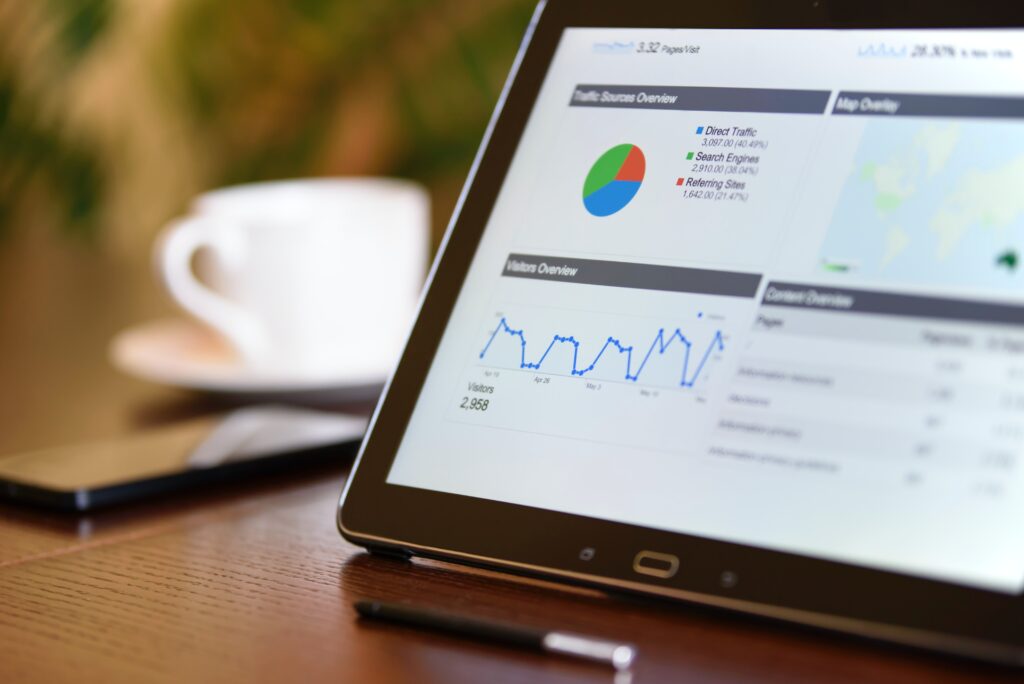
Why You Should Be Testing Your Google Ads

You may be asking yourself though, “Why test Google Ads in the first place? Isn’t paying Google enough? Is paying for Google Ads even worth it?”
If you’ve been reviewing your ad strategy and considering using Google Ads, or optimizing your existing Google Ad strategy, keep scrolling!
Table of Contents
- Overview of Google Ads
- Overview of A/B Testing
- Importance of Testing
- How to start A/B Testing yourself
- When to ask for help
Overview of Google Ads
Google Ads are an effective way to drive qualified traffic to your website by allowing you, the business, to create and share mobile and desktop ads with your target audience. Google Ads is a pay-per-click (PPC) marketing effort, meaning the advertiser pays per click or per impression on an ad. The benefit of paying for your Google Ads is that when your ideal customers search for products or services like yours in Google, your business will appear on their search engine results page (SERP).
Businesses can use Google Ads to:
- Boost website traffic
- Increase store visits
- Improve the customer experience
Are you asking yourself, “Do Google Ads even work?”
Google is a powerful search engine with over 5 billion search queries a day. It even has its own verb – “Google it.”
Here are a few statistics taken from HubSpot on Google Ads if you’re still unsure.
- Google Ads have a click-through rate of nearly 8%.
- Display ads yield 180 million impressions each month.
- For users who are ready to buy, paid ads on Google get 65% of the clicks.
- 43% of customers buy something they’ve seen on a YouTube ad.
Just starting out with Google Ads? Our very own Mike Wisby breaks them down in his article, “Everything You Need to Know About Google Search Ads.”
Overview of A/B Testing
Now that you understand Google Ads and their importance let’s discuss testing those ads. A/B Testing is a digital experiment where you have your control (your current view/layout) and variations (the changes you’ve made). Your control and variants are shown at random, and as visitors are served each variation, their engagement is tracked. Google will automatically measure and collect that information into their dashboard and analyze it through a statistical engine to see what users respond to and which ad performs better.
We use these metrics to determine the type of effect the change had on user behavior. What is good, bad, or the same? The more we understand your audience, what their eyes are drawn to, and what causes them to click, we can better serve them.
Lastly, the Google Ads tool allows you to create a “monthly cap” so your business can stay within its budget. You can also pause campaigns or add more funds. And who doesn’t like having control over their budget, am I right?

Importance of A/B Testing Google Ads
A/B Testing allows us to ask focused questions about changes and answer those questions. We’re able to see the direct impact of those changes. By testing your Google Ads, you’re able to take the guesswork out of ad optimization and make data-informed decisions.
How to Start A/B Testing Yourself
Before we jump into the nitty-gritty of how to run A/B Tests in Google Ads, you’ll first want to analyze your current metrics and put together your hypothesis.
Review Reporting
Start by collecting data and reviewing your analytics – Start by pinpointing growth areas. Then, put together a list of ads that you see performing well – with a high CTR (Click Through Rate), and a list with ads that aren’t performing well. Review the list, compare the verbiage you’ve used between the two, and make a note of the similarities or the differences.
Generate a Hypothesis
Running A/B Testing is essentially running an experiment; you have your control and your variants. Using the data you collected, make some guesses. Then, put together a list of A/B Testing ideas and the “why” for each. The “why” being, “Why do you think that this change will increase traffic?”
Lastly, prioritize your list of ideas by the ease of implementation or importance. Don’t go full-blast into testing something that may be difficult for you to implement or even understand on your own. The goal here is to see overall success with your Google Ad spend, not lose money because you’re implementing and testing ads that don’t convert.
Set-Up Your Tests
Now, how do you do it? Below we’ve included steps to create ad variations, filtering your ads, and the different types of variations:
Step 1: On the Page menu, select “Drafts and Experiments.”
Step 2: Click “Campaign Drafts.”
Step 3: Click “Campaign Experiments.”
Step 4: Select “Ad Variations.”
Step 5: Next select “New Ad Variation”; then click the campaign that you’d like to run the ad variation.
Two Trees PPC Tip #1: While you can create variations for all campaigns, we recommend implementing a new experiment for each campaign. This way, you have some control over your messaging. However, keep in mind that you cannot run overlapping variations within a campaign. You wouldn’t see the full impact if you ran multiple variations because your impressions would be spread too thin.
Filtering
Google offers a couple of ways to filter the ad copy in a campaign to ensure you create tests in the correct places. When putting together the filter, you will see the first variation that allows you to select ads based on your headline, description, or both. The second variation is a modifier. That portion enables you to include or exclude ads based on their content.
Two Trees PPC Tip #2: You can create and combine multiple filters, so don’t feel bound to one, but stay intentional with your filters.
Creating Ad Variations
There are three types of ad variations you can create:
- Find and replace
- Update text
- Swap headlines
Variation #1: Find and Replace
Find and Replace allows you to find a word or phrase in your text ads and swap it out with another. In addition, Find and Replace allows you to adjust the copy of your ads, and you have the option to match the case!
This is a good variation when you’re testing words like “Read More” or “Learn More.”
Variation #2: Update Text
When making significant changes that still require your filters, the Update Text variation is a good option.
Variation #3: Swap Headlines
This variation allows you to flip Headline One and Headline Two that you wrote out in your filter step. This is a great option if you want to test the location of a CTA (Call To Action).
Applying Your Ad Variations
Now that we’ve reviewed your filters and the types of ad variations, we can now establish the details of a testing process.
Step 1: Name your variant – You’ll want to use a variant that directly references your test, so you know what you’re looking at.
Step 2: Assign a start and end date for the variation.
Step 3: The final field before your new ad variation goes live is the “Experiment Split” section. The experiment split section refers to the split of your campaign budget. It’s the percentage of funds allocated to your campaign budget and the auctions your variation is eligible to participate in.
Step 4: Once the “Experiment Split” is filled out, click “Create Variation.”
Note: Where you made these changes will also be where the metrics for the variations will show, so when you want to see the results of your variation, head right back over there!
Step 5: Once you’ve reviewed the results of your ad variation and you want to move forward and update your remaining ads to match this variation, click “Apply.”
Step 6: This will bring up the “Apply Variation” screen where you’ll be provided a breakdown of your ad variation and three options.
Two Trees PPC Tip #3: Do not click the 2nd option. There is value in the old ads you ran, and you do not want to delete historical data.
Step 7: Pause your ads and replace them with your chosen ad variation, or run your variations as a true split-test.

When to Ask for Help
While the process of Google Ads and A/B Testing is relatively simple, the execution and maintenance can be time-consuming, especially for business owners who need to focus on their business and not solely their Google Ads. However, Google is one of the most powerful search engines, so while it can be time-consuming, your business needs to prioritize Google Ads and leverage its power in the digital space.
The question now is – should you manage it yourself, or should you work with a marketing agency, like Two Trees PPC, to oversee the campaign for you?
There are a few benefits to outsourcing to a marketing agency.
First, marketing firms have experience with Google Ads and historical knowledge of keywords and phrases that work within the Google space.
If this is your first time creating/managing a PPC campaign, you’re going to make mistakes. We all do. It’s a learning experience, but mistakes can be expensive, and an agency has the expertise to navigate a campaign and avoid those common mistakes. Their experience will also allow them to manage the process more efficiently. Experience, expertise, and efficiency all work towards creating an effective campaign that will drive more traffic to your website than managing your Google Ads and testing yourself.
Secondly, PPC Campaigns can be time-consuming. If you’re managing your campaign and this is the first campaign you’ve worked on, it could take even more time to do it properly. Not only do you have to learn how to set up a campaign, but you also have to take courses to understand PPC marketing, take time to track your metrics, and continue making changes to grow your business and optimize your ads. By offloading your Google Ads to an agency, you can free up time to work on your business while knowing that your agency is monitoring your PPC campaign.
Lastly, the cost-benefit of hiring an agency may sound contradictory, but while you are spending money on an agency, there is a direct return on that investment. By having an agency handle your PPC campaign, you’ll free up time, and the agency can use their experience to help your campaigns perform better than if you were to do it yourself. Therefore, outsourcing your PPC campaign can mean more success for your business, making it a wise investment.
So the big question: What is right for you? Managing a PPC campaign yourself can save you money by not having to outsource, and you can run campaigns your way, but it can also take a lot of time if you’ve never managed a campaign before and could end up being costly if you make a mistake. So while either option is doable, take a minute to reflect on the time you have available daily. Do you have the time to take on this responsibility? Do you have the time to learn about Google Ads and A/B Testing ads? Do you have the time to consistently reflect, A/B Test, and modify your ad copy? The decision is yours, but be intentional and honest with yourself about what you have the bandwidth to take on.
If hiring an agency sounds more appealing or if you’re looking for more information, Two Trees PPC offers free consultations where we can thoughtfully look at your business and help you make a decision that’s right for you. In the meantime, check out our services page to see each of our services, and if you’d like to stick with Google Ads only, head to this link where we talk all things Two Trees PPC, Google Ads Management, and the process.
Business owners – If you’re currently running the Google Ads for your business and running any A/B Testing, we’d love to hear all about your experiences – join the conversation on LinkedIn, where we can talk about A/B Testing, Google Ads, and so much more!


